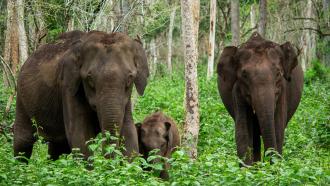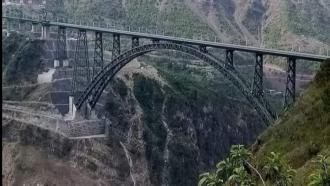Photo Credits: Vidisha Kulkarni / Research Matters
The vivid and myriad colours of the natural world captivate our eyes and benefit life on earth. Learning how nature colours its palette advances our understanding of the world around us and hence scientists ubiquitously are trying to imitate designs inspired by nature, to fabricate better devices. Now, a collaborative study between researchers at the Jawaharlal Nehru Centre for Advanced Scientific Research (JNCASR), Bengaluru, and the Indian Institute of Science (IISc), Bengaluru, has proposed a novel technique to build better display devices that imitate naturally occurring colours.
“Colours are one of the most striking ways in which Nature showcases her beauty. Be it the vividly patterned wings of the butterfly, the elegant feathers of the peacock or the myriad-coloured birds. However, unlike the colours due to dyes and pigments, most of the colours observed in living organisms are primarily due to underlying periodic structures. Nature remarkably self-assembles these structures from individual building blocks that could be as small as a millionth of a millimetre”, exclaims Mr. Chandan Kumar Mishra, a Ph.D. student at the Soft Matter Lab at JNCASR.
Colours displayed using periodic structures, like crystal lattices and solid molecules, are called structural colours. These could have extensive applications in today’s world of technology. However, one of the main limitations has been in our ability to artificially grow these structures. “The colloidal particles that we work on are in the micron scale, roughly 10,000 times bigger than atoms. These particles are big compared to the more commonly used atomic and nano-sized particles. And their size affects their mobility - a measure of the ease with which a particle can travel on a surface. Low mobility of colloidal particles makes it harder for the particles to travel across the surface to the exact location where they are to be deposited”, explains Prof. Rajesh Ganapathy, an Associate Professor at the Soft Matter Lab at JNCASR.
Conventionally, evaporation and use of an electric field to manoeuvre the colloidal particles to its destination are two popular techniques in use. But these techniques do not allow control over either selecting a specific location or the structure of the growing crystal. The proposed new technique overcomes this obstacle by designing surfaces with energy gradients that not only aids the colloidal particles in reaching their specific destination, but also allows control over the structure of the growing crystals.
“We have used a Moiré pattern, obtained by super imposing two geometrical patterns or lattices, at an angle. This creates periodic modulations in channel depths in the template. By now introducing attractive interactions which are sensitive to local channel depths, the modulations are converted to energy gradients that guide particles to desired sites. While the Moiré pattern moves the particles, the underlying lattice allows control over the symmetry and structure of the growing crystals”, explains Prof. Ganapathy on this technique. Once the particles grow, they can be seen through an optical microscope, thus enabling easy and immediate inspection of the designed specimen.
By growing crystals which would selectively sactter Red, Green and Blue lights in a periodic pattern, this technique could be a replacement to the conventional LED and LCD monitors, by imitating structural colours like the ones found in nature. Apart from its applications, the new study also sheds light on the more fundamental aspects of crystal growth and the interaction between the surface and particles, helping us understand the basic building blocks used in the natural world.
About the authors and work:
- Prof. Rajesh Ganapathy is an Associate Professor and heads the Soft Matter Lab at JNCASR. Contact: rajeshg@jncasr.ac.in
- Prof. Ajay Sood is a Professor at the Department of Physics at IISc. Contact: asood@physics.iisc.ernet.in
- Chandan Kumar Mishra is a Ph.D. scholar at the Soft Matter Lab at JNCASR. Contact: mishrachandan23@gmail.com
The paper titled ‘Site-Specific Colloidal Crystal Nucleation by Template-enhanced Particle Transport’ was published in the Proceedings of the National Academy of Sciences Journal, USA.

























